
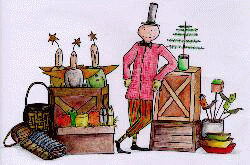

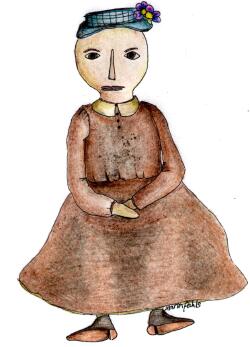
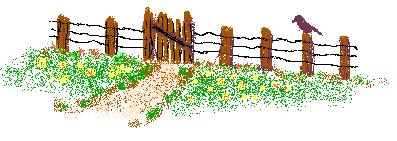
the fence post
dear friends:
at the time of this issue, in march of 1999, i had just finished holding some doll making classes at my home. i remember it like yesterday! i was a little nervous about demonstrating my techniques and whether the students would understand what in the world i was trying to show them. it is so different from authoring patterns because i was actually showing and explaining "how to" all at once.
the first day we did a prairie rag doll, my dear ina dibble. i demonstrated several techniques for finishing the face. the doll i was demonstrating on became none other than the original "mavis" - a sweet black doll with a wonderful story. mavis later became a pattern in 2000.
day two was a garden angel for which i pre-dyed some wool dresses. besides regular dye i tried kool-aid drink mix. it was delightful to see so many different dolls result from the same basic ideas. there was no shortage of spittin' and cussin' when we had to turn the little tiny pieces of fabric but it was all in fun.
day three was just me and ellie making a fun batting rabbit. i had just come up with the design right before the class as i always end up creating best under pressure....
the thing that i kept finding myself repeating each day was "this is how you do it, of course unless you want to do it another way" . because as you well may know there is no right or wrong way to make dolls or do any form of art. each person's way of creating is unique and that is the truly great thing about it-how our uniqueness comes thru in our creations. of all the teachers i've had in my life, the really great ones, are those who let me find my own path-
primitively yours,
maria pahls
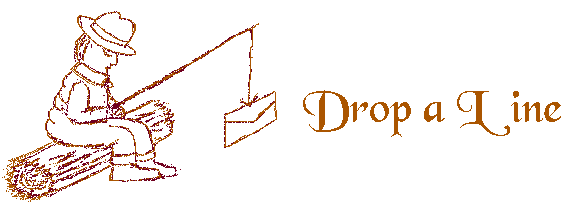
miscellaneous letters sent in by readers
ellie is so funny, she is giving poor ruth a hard time (these two gals were buddies for the entire time they were at my classes)
"Dear darling Girl..... Thanks sooo much for the weekend of doll making... it was such fun.... I am always amazed with your many talents... and kinda in awe!! You make cute babies both real and in cloth.... you must be very special to God!! YOU ARE VERY SPECIAL TO ME!! I've been trying to reach Ruth (you know that really mouthy one with blonde hair..ha!) I get her answering machine and she calls back and says she'll sit by the phone until I get back.... well, I called her back and guess what???? she was away from the phone... I don't know if I'm going to allow her to be my FRIEND after all.... what do you think!!!I just wanted to rub it in and tell her WHAT SHE MISSED!!!!! WHAT A GREAT TIME WE HAD!!!Hugs... Ellie (the nice quiet one)"
cherie reynolds sent in this thought provoking piece...
"I just saw a great episode of "Sunday Morning" on CBS; on outsider art. They mentioned a wonderful Black artist who used chewing gum as sculptural material in her doll making.
It reminded me of the current discussion brewing on the strong negative reactions of some "traditional" doll makers to primitive doll artists' work. I think there is an important cultural event occurring in the doll making world (and the outside world at large). And I believe that your magazine is tapping into this movement.
I volunteered at the Santa Fe International Doll Art show several years ago and was pretty dismayed at some of the demeaning comments regarding cloth doll artists in general. Any art form that is embraced by a majority of women will always be challenged to gain acceptance by a male dominated field, as art is. So I look at all the fuss as a mere posturing of some of the artists who have been "accepted" or those who are struggling to be embraced by the art world at large. I find this struggle occurring within every time I pick up my needle. I have formal training in art yet I am drawn to nontraditional expressions of self (also have training in Art Therapy). So I struggle to discard the more standard definition of form and function to create a meaningful work using the simplest of materials. This is what I most admire about the artists featured in the seed pod. They seem to have won the battle.
What many of your members refer to as country cute is the commercial response to the aforementioned movement. And as such it satisfies the majority of people. Truly primitive art held in disregard and dismay by many, is a more intrinsic and personal reaction to this trend. I fear when primitive art reaches a level of acceptance by a majority of people it too will become trivial and meaningless. For this reason I would caution any primitive artist to resist the urge to create a middle ground, ie to concentrate on producing pieces that will be accepted by the majority and thus sell well to the majority of shopper's. Instead choose to continue to create in accordance to the self and not in reaction to what most people already know and want to hear. Instead listen to that small voice that demands expression. You will find it only by denying the obtuse and popular -the easiest answers are not the true answers.
Of course this means less financial success, at least in the immediate future, but a greater personal satisfaction is the reward. (perhaps this is all too idealistic). But then, one must ask themselves, WHY in our society is it that to maintain one's ideals is counter to being successful? (or at least maintaining one's ideals is the most difficult of paths to pursue?)"
on raggedy hair (question from issue#68):
primitive ponderings
questions asked by readers, then replied upon in later issues.
"I may have an alternate way for Cheri to do Raggedy hair. I've done it and folks like it a lot. Try "loopies"-you know those bags of knit circles that kids make potholders with? You can buy full bags of just faded out red. Just sew them on for the hair."
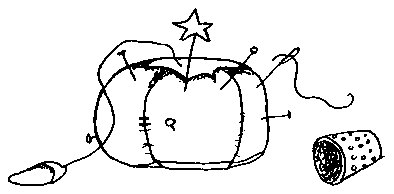
tips & techniques
giving eggs
paint cardboard egg crates in milk paint colors and fill with wonderful home-dyed and decorated eggs. tie shut with string and present as a hostess gift or for that special friend.
twig tree spring face lift...
remember that twig tree we talked about for halloween? well pull that out for spring. using the twiggy branch mounted in a wooden base you can embellish with small woolen carrots, painted muslin rabbits, even the beautiful heirloom type seed packets available at garden stores. of course tiny baskets, old batting chicks, lambs from your nativity set, wooden eggs (use eye hooks for hangers) and moss would also look great and surely would welcome your guests this spring.
sprouted grass
try planting rye grass seed in a shallow lined rustic wooden trough. the grass sprouts in a few days and eggs or other decorations can be nestled into the green shoots for a wonderful spring look.
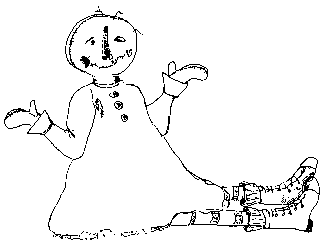
WHAT'S IT?
blue-white stoneware american shaded blue-white stoneware was produced in quantity for utilitarian purposes beginning in the late 1800's until well into the 1900's. though similar objects with a brown or green glaze were also produced but the blue and white seemed most popular. the examples of this form of stoneware were rarely marked and had no specific name...it has been called by german blue stoneware, blue crockery, salt glaze pottery and blue flemish. (most of these terms were from catalogs selling the pottery). decoration varies from embossing of figures, trees, flowers & birds,to a smooth shaded surface. there are upwards of 80 different patterns in this style pottery.
chalkware "chalk" is actually plaster of paris. These are generally decorative figures. though the first known examples of the figures were imported from england this type of ware is often associated with the pennsylvania dutch. mostly they were inexpensively made copies of pricey porcelian,pottery or parin figures often having using the more expensive pieces to make the molds. though the chalk "images" as they were called, were available in the 1700's today's surviving examples are mostly from 1850-1890 when peddlers traveled the country selling these as part of their wares. the pieces were lightweight with hollow centers having been cast in two part molds. the bases were often sand filled to counter their top-heaviness. subject matter included all sorts of animals as well as fruit, houses and angels (the later 3 being the most rare today). these were often decorated haphazardly sometimes giving a garish appearance. in some cases a slot was added to form a "penny bank". chalk ware is still created today though only true age will bring about the change in texture that surviving original pieces have.
graniteware sometimes referred to as enamel ware or agate ware was made in the late 1800's until about 1930 when it was replaced by aluminum ware. the granite ware was prone to chipping which limits the chances of finding an intact piece today. the pieces made ranged from pails to utensils, pitchers, bed pans, coffee pots, funnels dippers and molds. it is being reproduced in modern times with the revived interest in country living.
redware redware is one of the most popular forms of country pottery and is and was widely made through out the u.s. generally it has a soft porous body with varied coloring depending on the hue of the clay and glaze used. the glaze serves the purpose of intensifying the warm color while at the same time sealing the piece. in early times pieces were hand formed and wood fired often causing warping and irregularity. characteristic of pie plates, deep dishes and platters was an unglazed outside often charred from use.
highly desired by collectors are the "sgraffito" pieces which have a scratched or incised line decoration. this style of finish was more for decoration than utility. "slip", another finish variation, was made by tracing the design on the redware form with a creamy consistency clay in a contrasting color. since these pieces were more utilitarian the raised design was pressed or pounded into the piece, the simplest forms contained lines and dots the more interesting forms contain names, or other inscriptions. other slip decoration included motifs such as human figures, birds and animals-many with symbolic meanings. a final type of finish on redware was a manganese glaze which was smeared onto the surface and after firing revealed many interesting shapes.
spatterware generally tableware,laboriously decorated with a hand drawn motif such as birds, flowers etc with a spatter decoration as the background, produced up to 1850 and generally not marked. it was chiefly produced in staffordshire, scotland and wales for the american market. two forms of spatterware are gaudy dutch and gaudy welsh and it is often regarded as pennsylvania dutch due to it's popularity with the german settlers of that state.
the term "spatter" applies to the over all effect of the decorative technique rather than to the technique itself. the spattering was applied with a sponge or brush by patting or dabbing onto the piece. pieces exist in many colors with yellow being the most rare. the center design was done in freehand and many motifs exist.
another form of spatterware is stick-spatter which combines the spatter technique along with applied transfer-painted bands. produced from 1850 to 1900, the transfers were done as an aid to quick production of otherwise time consuming process. this technique was done with cut out sponges in the shapes of hearts, rosettes and vines as well as geometric. this type was imported as well as produced with in the country. these too, are seldom marked.
spongeware spongeware as it is known was decorated white earthen ware. to the white clay base colors such as blue, blue/green, brown tan/blue was applied. the object was then bathed in a clear alkaline glaze. because the hue was often sponge-applied the term "spongeware" became common. blue was the most available color, pieces are rarely marked and pieces include bowls, pitchers, bean pots and cookie jars.
stoneware another form of country pottery which was begun around the mid 1700's and because of it's popularity was mass produced until it waned in the end of the 1800's.
stoneware is a weighty dense and durable pottery made from clay mixed with sand or flint or very siliceous clay that vitrifies when heated to form a nonporous base. the pieces were most often glazed inside and out to prevent porosity and resist chemical reactions. most is salt glazed. this was done by throwing common table salt that had been heated into the kiln during the height of the firing heat. the heat caused the salt to vaporize and covered the objects with the clear thin glaze that coined the name "salt glaze". sometimes the salt did not vaporize before hitting the wares and a pitting would result in the surface of the pieces.
stoneware that was not salt glazed was often slip-glazed. this was clay mixed with water and applied as a finish. this mixture fused into a natural smooth glaze during firing. prior to 1850 stoneware crocks and jugs were thrown in an ovid shape and later as straight sided more cylindrical shapes. early pieces were unadorned and later motifs, generally in blue sometimes in brown, included birds, animals, figures even landscape scenes. during it's popularity wane stoneware was sometimes decorated using stencils.
marked and dated pieces are most sought after and as a general rule the more cobalt blue in a piece the more desirable it is. during years past homemakers would store, salt and pickle in these containers where as today they are used more for decoration and utensil storage. this form of earthen ware is still produced today.
yellowware yellowware was another form of pottery and perhaps the least adorned of earthenware. it spans from about 1840 to 1940. the body texture of yellowware is finer, less dense and vitreous than stoneware. forms were almost always simple and utilitarian and colors varied from deep yellow to an pale buff and as redware had a glaze to intensify the color. in some cases the pieces were banded with a second color of slip such as brown, white, yellow, blue or black. few of the pieces were marked so they cannot be attributed to any one factory. an interesting note is that much of the old yellowware found today came from zanesville, cincinnati and east liverpool ohio with a few of the rarer pieces being produced in bennington. the rare ones include: pie plates, deep custard cups,pipkins, figures,cow creamers and toby snuff jars.
Artist Interview
TISH BACHLEDA
THE TWEED WEASEL
HANDCRAFTED DESIGNS
MP: tell us tish,how long have you been making primitives?
TB: In September of 1996, I started frequenting a small primitive shop only a few miles from my home-- that's what introduced me to the "primitive" style. I fell in love instantly!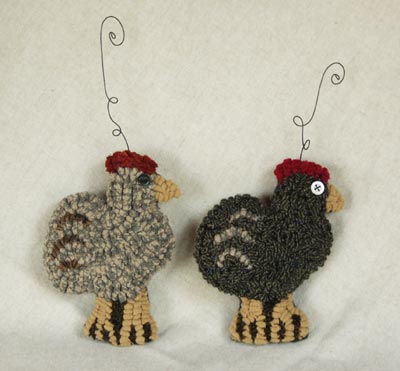
Later that year the shop owner invited me to take part in her Christmas Open House... and THAT was the start. In October of 1997 "The Tweed Weasel Handcrafted Designs" was established. I began by making dolls and other gifts from patterns I bought. By early 1998, I began creating my own original designs and released a line of patterns the following year.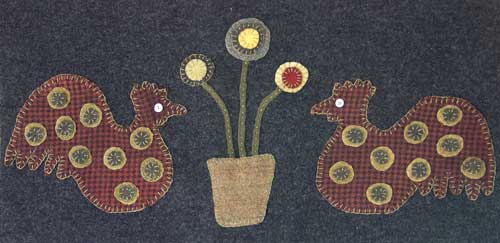
MP: what inspires you and your work?
TB: Everything and nothing. One idea always leads to many more.
MP: do you have any one favorite theme?
TB: Halloween, of course. It's my favorite holiday for designing. I love the pumpkins, crows , stars and all the rich colors of fall. Despite a passion for pumpkins, I really design items for every season and I love it all.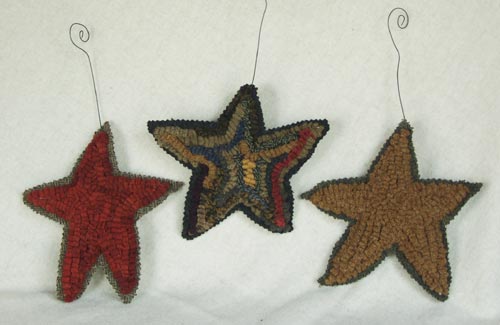
MP: neat! tell us about the other items please....
TB: I do many different types of primitives....but rug hooking is what I truly love to do. Few people have an appreciation of all the time involved in making a rug and the prices often surprise buyers. My line has grown to include smaller hooked items that everyone can afford...such as purses, wallets, eyeglass cases, necklaces, hanging pockets, Christmas stockings, tote bags, scarves, hats, table mats, ornaments and dolls.
I still do other things as well....I love wool so many items are made of wool: penny rugs, pincushions, dolls, topsy turvy dolls, angels, all types of seasonal items....and much more.
MP: those sound great, what are your hobbies and interests?
TB: I enjoy flower gardening, reading and drawing.....but I must say that what I do for a living is also what I do for myself for fun...the only difference is that it will decorate my home and not someone else's.
MP: i found it interesting that your husband, too, is an artist are there other artists in the family tree?
TB: Everyone in my family is pretty talented -- my grandfather was a very skilled carpenter, my grandmother makes beautiful embroidered linens, my mom's a great decorative painter, and my dad inherited my grandfather's love of wood and furniture building. They all say they wonder where I got my interests and talent. I have no question. I grew up around people creating things with their hands.
thank you tish, and best wishes for your new shop!
All pictured designs are
The Tweed Weasel Originals
copyrighted 2001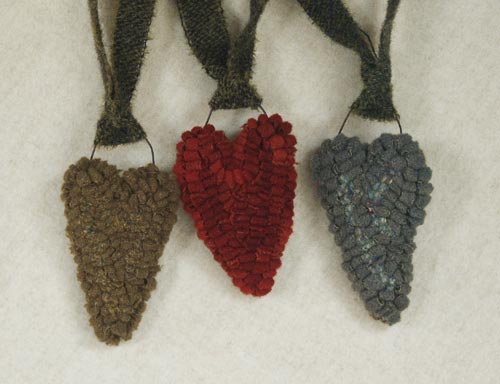
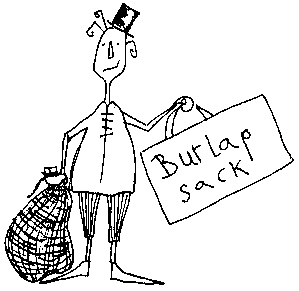
Tish Bachleda
The Tweed Weasel Handcrafted Designs
407 West Main Street
PO Box 407
Schaefferstown, PA 17088-0407
info@thetweedweasel.com
Shop hours:
Friday 9am-5pm
Saturday 9am-1pm
All other hours by appointment.
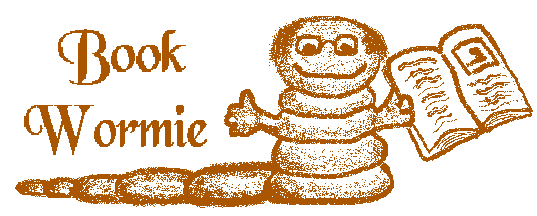
book reviews
&
books of interest
stoneware books:
American Stoneware
(A Wallace-Homestead Price Guide)
by Don Raycraft, Carol Raycraft (Contributor)
Paperback (June 1995)
Wallace-Homestead Book Co; ISBN: 0870697145 ;
Collector's Guide to Country Stoneware and Pottery by Don Raycraft Paperback 2nd edition (April 1990)
ISBN: 0891454209
granite ware book:
The Collector's Encyclopedia of Granite Ware : Colors, Shapes and Values
by Helen Greguire
(September 1989)
Collector Books;
ISBN: 0891454128
book on redware:
Redware, America's Folk Art Pottery
by Kevin McConnell
Paperback (March 1997)
Schiffer Publishing, Ltd
ISBN: 0887401597
sponge & spatter ware book:
Spongeware and Spatterware
by Kevin McConnell
Paperback
2nd edition (January 1999)
Schiffer Publishing, Ltd.
ISBN: 0764307681
yellow ware books:
Collecting Yellow Ware Book II: An Identification & Value Guide
by Lisa S. McAllister, Lisz McAllister
(October 1996)
Collector Books
ISBN: 0891457410
19th and 20th Century Yellow Ware
by John Gallo ck
(December 1985)
ISBN: 0961564806
Yellow Ware
by Joan Leibowitz, Liebowitz
(September 1985)
Schiffer Publishing, Ltd.
ISBN: 0887405088

web sites of members & other sites of interest
sites with redware
slip decorated redware from snowhill nunery:
http://www.maineantiquedigest.com/articles/bowl1197.htm
redware painting at national gallery of art
www.nga.gov/collection/gallery/iadpot/iadpot-20234.0.html
steve nutt, a redware potter has a web site and mail newsletter
HTTP//:WWW.STEVENUTTPOTTER.COM
a picture of yellow ware at antique center
http://www.antique-center.com/zpapern3.jpg
here is a place you can get stoneware crocks from:
http://www.ransbottompottery.com/index.htm
antiques & dolls / arw antiques
http://www.arwantiques.com/
stephen & carol huber antique samplers
http://www.antiquesamplers.com/
hard to find needle work books
http://www.needleworkbooks.com/
a teaching site for antiques
http://www.antiques-oronoco.com/
shepherds seeds
http://www.shepherdseeds.com/
decoys and a quick carving lesson from will kirkpatrick
http://www.KIRKPATRICKDECOYS.COM/
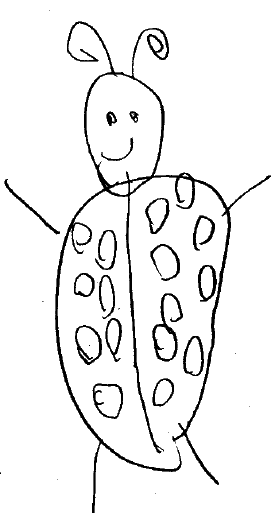
prose
If you ever need a helping hand,
you'll find one at the end of your arm.
As you grow older, you'll discover that you have two hands:
One for helping yourself, the second for helping others.
"Soon the frail eggs they shall
Chip, and unspringing
Make all the April wood
Merry with singing."
(from "nest eggs" by robert lewis stevenson)
"Of speckled eggs the birdie sings
And nests among the trees;
The sailor sings of ropes and things
In ships upon the seas"
(from "singing" by robert lewis stevenson)
I'm everyone's darling: the blackbird and starling
Are shouting about me from blossoming boughs;
For I, the Lent Lily, the Daffy-down-dilly,
Have heard through the county the call to arouse.
The orchards are ringing with voices a-singing
The praise of my petticoat, praise of my gown;
The children are playing, and hark! they are saying
That Daffy-down-dilly is come up to town!
The Song of the Daffodil Fairy ~by cicely mary barker b.1895-1973
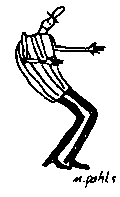
|
|
All rights reserved. No part of this newsletter may be reproduced without written permission from the publisher, except by a reviewer who may quote brief passages in a review with appropriate credits; nor may any part of this newsletter be reproduced, stored in a retrieval system, or transmitted in any form or by any means -- electronic, mechanical, photo- copying, recording, or other -- without written permission from the publisher.
 HOME PAGE
HOME PAGE